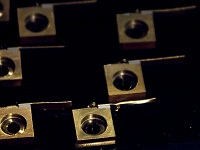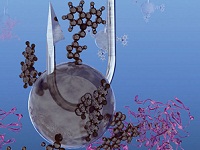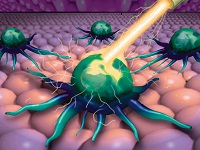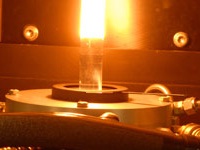No, we don’t make eyeglasses.
stories and images by Neil Caudle
This is what Eric Johnson has to explain, outside of work. But what he does make, with his team of savvy students, takes vision.
If you look across the country, what’s one of our biggest challenges?” Eric Johnson asks. “We don’t make things anymore.” Johnson would like to help reverse that trend. He and his students make things. They design and build the sort of devices that could give homegrown industries a fighting chance against foreign competition. Infrared lasers. Silica mirrors for high-precision optics. Imaging systems. Optical transceivers that transmit and receive data. Etched glass for solar cells and semiconductors. Devices so tiny they could fit on a chip in your cell phone.
The optics industry, as Johnson sees it, sits on a mother lode of untapped potential. But the very diversity of materials and possible applications that gives optics its vast potential also complicates its industrial development. Manufacturers have trouble sorting out their options, and investors don’t know where to place their bets. As a result, the optics industry lags behind the electronics industry by a couple of decades, Johnson says.
“With the integrated-circuit industry you have silicon,” he says. “Everything is built around silicon. The industry can introduce one new material at a time, and they can all adopt it, learn how to apply it to the silicon, and move forward. So it’s very controlled in terms of the options you have for integration. But photonics is much more diverse—it’s all over the place.”
In conventional integrated circuits, information flows as electrical current—electrons—from source to detector through channels on a chip. Photons move faster than electrons but are harder to channel along a circuitous route from point A to point B. So integrating optics with electronics in a chip or tiny device is a challenge.
Consider, for example, the case of LEDs. For years, people have predicted that LEDs—light-emitting diodes—would replace incandescent light bulbs. LEDs save energy, and the lights themselves can be intelligent devices, communicating and following instructions. But LEDs have not replaced the incandescent light, and the reason, Johnson says, is cost. “How do you manufacture the LEDs,” he asks, “and how do you integrate them at a cost that’s competitive with an incandescent bulb?”
Johnson raises a similar question about one of the world’s newest energy hogs: data centers, which handle everything from email to banking transactions. According to a report in the New York Times (July 31, 2011), data centers now account for between 1.7 and 2.2 percent of all electricity consumed in the U.S., and demand is growing. Worldwide, energy use in data centers rose 56 percent from 2005 to 2010.
Most of that power goes into routing information from one system to another, using wires and electrical devices, Johnson says. Light pipes and other optical equipment could route the information faster using far less energy, and Johnson’s lab is developing devices that would help do that. But for data routing, as with LEDs and hundreds of other technologies, integrating optics and electronics is a big hurdle. Crossing it will require highly skilled leaders and workers—people savvy with math, physics, chemistry, engineering, and the nuts-and-bolts practicality of manufacturing. “This is the biggest demand in industry today,” Johnson says, “people who can cross those disciplinary boundaries and understand the technologies.” Those people, he says, are the real product of his lab.
Fortunately, he says, students like to make things. “They see the value in it. They understand connecting the theory with the design and the fabrication—that’s where you’ll get the real return on investment for research.”
His was not the usual path to a job fighting cancer. Stephen Foulger was a California dude, a surfer and gear head who built motorcycles.
Sung-O Kim came to COMSET to work on displays and wound up taking aim at cancer. Not that cancer is the lab’s only target.
Fiber optics spread the Internet around the globe, but the science of light is just warming up. Go back to Material advantage and the power of light.
For now, we can introduce you to only a few of the people at COMSET, and we’ll have to save a number of researchers for issues to come. Or visit the COMSET website.
Eric Johnson is a professor of electrical and computer engineering in the College of Engineering and Science. He is also the PalmettoNet Endowed Chair in Optoelectronics and head of the South Carolina SmartState Center of Economic Excellence in Optoelectronics. Private industry and the Department of Defense sponsor much of his research.









